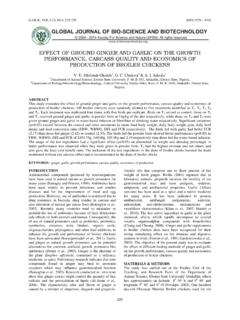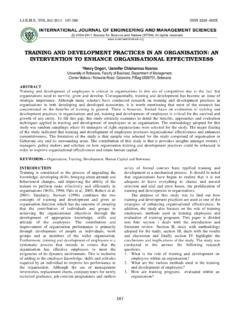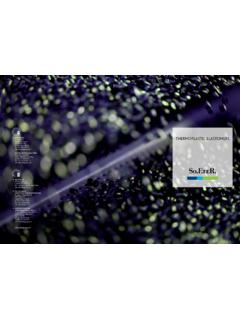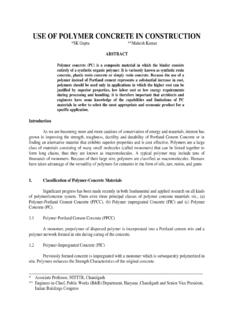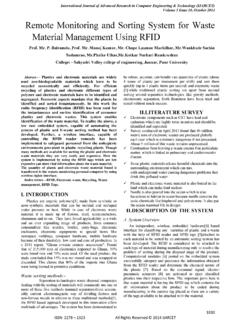Transcription of THE EFFECTS OF LINEAR LOW-DENSITY …
1 , (2) 2012:85-90 ISSN 2229-600X85 THE EFFECTS OF LINEAR LOW-DENSITY polyethylene ( lldpe ) ONTHE MECHANICAL PROPERTIES OF HIGH- density polyethylene (HDPE) FILM BLENDS*Ogah, J. of Industrial Chemistry, Ebonyi State University, Abakaliki,Private Mail Bag 053, Ebonyi State, NigeriaABSTRACTP olyethylene is a synthetic polymer that has been explored for various applications, such as films and packaging , studies involving HDPE/ lldpe film blends has received limited attention. The effect of lldpe on the mechanicalproperties of HDPE film blends was investigated. Films of HDPE/ lldpe blends were produced by extrusion moulding usinga Co-rotatory Twin-screw Extruder.
2 The blends were characterized using Capillary Rheometer, Elmendorf-Type Tear Tester,MLANO/ITALIA Dart-Impact Tester and ILAO TIEH Instron Tensile Testing Machine, Model 1026. Results showed that, theMelt-Flow-Index (MFI) and tear (tensile) strength increased with increasing amounts of lldpe , but the impact strength, yieldstrength and secant modulus decreased :Mechanical properties, Film blends, Extruder, Tensile strength, Dart density polyethylene (HDPE) is made by low pressuremethods. In this method, pure ethylene is polymerized at apressure of about 50 atmospheres and temperature between60-200oC in the presence of Zeigler Natta catalyst systemand supported oxide catalyst1.
3 Such polymers are over 90%crystalline, sufficiently LINEAR compared with low densitytype and density above The low densitypolyethylene (LDPE) is made by high pressure methods. Inthis case, the pure ethylene is polymerized at a pressurebetween 1x103 3x103atmospheres, temperature of 250oCand using a O2free radical initiator1. Thecrystallinity of such a polymer is low (50-60%), density isabout the polymer is highlyamorphous, highly branched due to chain transfermechanism and readily dissolves in many organic solvents atabout 100oC.
4 New procedures for producing LDPE at lowerpressures involving polymerization of alpha-olefin withethylene usually from C3to C8carbon chain length has beenevolved1, 2. These new LDPE have increased linearity, with asmaller amount of alpha olefins as co-monomers, densityrange of are referred to as LINEAR lowdensity polyethylene ( lldpe )Blown films from high density homo-polymers tend tobe very brittle because they lack tie molecules. Low densitypolyethylene however, is used mainly for the production offlexible materials such as films, while high densitypolyethylene is used for utility goods such as crates, seatsand containers3.
5 The lldpe on the other hand, hasimproved physical properties quite superior to theconventional LDPE product especially with respect to theirresistance to certain solvents. The use of highly active andstereo-specific catalysts, such as the Zeigler-Natta catalystshas enabled product specifications such as linearity, specificdensity and melt-flow index. The linearity in the polymerstructure imparts better tear and tensile properties4, while thechain branching caused by the alpha-olefinic co-monomers,account for the inherent toughness of the lldpe properties confer on lldpe certain physicalattributes which are generally more useful than those usuallyassociatedwith the LDPE in several applications.
6 It istougher and has better tensile and impact properties, higherstress crack resistance and puncture energy. It also has bettersealing characteristics and yields cheap end products byallowing up to 30% down-gauging when compared withLDPE5, 6. The heat seal and hot tack properties are excellentover broad sealing temperature ranges7. LINEAR low densitypolyethylene films are thus suitable for a host ofapplications, such as mulching, packaging of consumergoods,and industrial products such as fertilizers. Theiroutstanding tear strength in the transverse direction, TD, alsomakes lldpe resins particularly suitable for stretch HDPE resins are used for the manufacture of heavy dutyfilms forfertilizers, planting and merchandisebags/containers.
7 Other applications include extruded netting,oriented tapes and monofilaments8. The mono-and multi-filaments of polyethylene , like polypropylene (PP), mayserve a good purpose for making ropes, cordage, webbingand automobile seat covers. Bulk continuous filament isused in carpets, twines, brushes and fabrics. Most polymerfilms go into packaging applications, electrical insulationand constructional materials9, use properties ofHDPE may be improved by one of four ways, namely:increasing the molecular weight, incorporating smallThe EFFECTS of LINEAR LOW-DENSITY polyethylene ( lldpe ) on the mechanical properties of high- density polyethylene (HDPE) film blends86amounts of co-monomers such as butene, hexene, or octene,cross-linking and by blending with impact less commonmethod for toughening HDPE isachieved by adding some type of rubber.
8 Though thismethod improves the toughness of the resin, particularlywhen it is converted into film, it tends to destroy some of thedesirable properties of the polymer11. Addition ofrubberdecreases the modulus of the polymer and the barrierproperties as the amount of rubber is increased. The sameeffect can be obtained by incorporating LDPE or lldpe into the HDPE although these may improve some of the has also been made tougher by blendingwith HDPE or LLDPE13. Ward14has also explored thepotentials of blending PP with LDPE, lldpe and HDPE inorder to improve the mechanical properties of recycledpolyolefins.
9 The focus of this study therefore, isto determinethe EFFECTS of lldpe on the mechanical properties of HDPE blends. The results of this study will hopefully expand theapplications of both AND EXPERIMENTSM aterials:The LINEAR - LOW-DENSITY polyethylene resin (gradeF1U) andthe high- density polyethylene resin (grade F8A)were obtained from the Plastic Technology DevelopmentCentre (PTDC), Eleme Petro-Chemical Company Limited,Port Harcourt, Rivers State, Nigeria and were used and Characterization ofLLDPE and HDPEB lendsA sensitive electronic read-out weighing machine, Europe1700 Model was used to measure a 100g of each blendportion of the lldpe and HDPE pellets respectively.
10 Theblend ratios obtained by mixing lldpe and HDPE resinsare shown in Table 1: Blend Ratio (w/w)Blend123456 HDPE (g)1009070503010 lldpe g)01030507090 Each of the blends was pulverized using a mechanicalblender to ensure thorough mixing. The blendedcomposition was charged into a Belton Extruder, Londonmake, at the following operating conditions:die-headtemperature of 183+10C, screw speed, 25 rpm andthe motorload of blend composition was then passedthrough the die head orifice of the extruder whichdetermines the thickness of the blown films.

